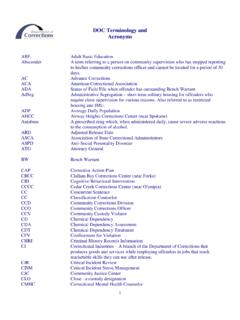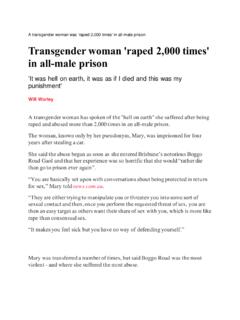Transcription of Maintaining Professional Boundaries
1 Interactions &. Professional Boundaries for Volunteers Annual Volunteer Training Overview It is important to understand that when you see the term staff used, this refers to paid employees of the Department of Corrections, all volunteers, and all contract staff alike. This presentation will cover the following topics: Boundaries Professional /Purposeful Relationships Appropriate Attire Red Flag Behaviors Confidentiality What are Boundaries ? Boundaries are guidelines, rules, or limits that a person creates to identify reasonable, safe, and permissible ways for other people to behave towards them and how they will respond when someone passes those limits. Why Do Volunteers Need Boundaries ? Professionalism and good Boundaries will protect you and those you work with. Clarity about what you are doing and why, will help you focus your efforts and create good Boundaries . Purposeful Relationships . How can you maintain a good rapport without risking exploitation? Building a good rapport with others is important.
2 You can and should be friendly, but understand that it is with a purpose. Be cautious and always remember to stay within the scope of your duty (the reason you are coming into the prison ). What constitutes a purposeful relationship? A purposeful relationship is about THEM and not YOU. It is often said by volunteers that they get more out of volunteering than the incarcerated individuals do. Many feel that working with this population is a calling . It is important to keep in mind that this relationship is about the THEM and not about YOU. Purposeful Relationships . You serve as a role model for the incarcerated men & women to follow. They not only learn what you speak of, but they also learn from your actions and how you present yourself. It is imperative that you respect your Professional Boundaries and stay within the scope of your duty, just as a doctor would with a patient or a teacher would with a student. Have you ever had anyone cross those Boundaries with you or your family members?
3 Maintaining Professional Boundaries Do not share information about your family, your relationships, your marital status, financial status, or personal issues you may be experiencing. If asked, simply say, We're here to focus on your work, not to talk about me.. Not only will the incarcerated individuals respect this, but it sets the tone for future conversations. Do not do favors for the incarcerated individuals: Treat them alike and do not do special favors for any of them. Keeping Professional Boundaries ~ Financial Dealings ~. Do not have ANY type of financial dealings with the incarcerated individuals: You cannot send the incarcerated individual and/or his/her family money, gifts, information etc. You CANNOT put any money on the incarcerated individuals account REGARDLESS of the situation. Not so they can make phone calls Not so they can mail items Not for medical expenses Not for schooling Not so they can buy necessities, etc. Keeping Professional Boundaries ~ Gifts ~.
4 There are many very talented individuals who are incarcerated. Often times, many of these men & women wish to extend their gratitude to you for offering your time and service. You cannot accept anything from an incarcerated individual and/or his/her family to include: Money Gifts (of any kind). Services Professional Boundaries ~ After Release ~. It is important to understand that the term incarcerated individual . refers to any individual who is currently under Department jurisdiction or has been discharged from Department jurisdiction within the past 6 months. Professional Boundaries ~ After Release ~. Can staff have friendships/relationships with released individuals? Can they serve as a mentor or support for the individual after their release? **Not Without Advance Approval from the Appointing Authority**. When an incarcerated individual is released from prison , he/she is still under the Department's jurisdiction; therefore policy PROHIBITS contact unless the Appointing Authority approves in advance.
5 Professional Boundaries ~ After Release ~. What if the incarcerated individual attends the same church or community organization as you do? If the staff member plans to have communication with the individual: He/she would need to complete the Report of Contact/Relationship with an Offender form and submit to their Volunteer Supervisor/Community Partnership Program Coordinator (CPPC) at the facility(ies) they volunteer at. The request for communication would need to be approved prior to the relationship. If the staff member does not plan to have communication with the individual and it is a casual contact: There is no need to submit the form. Professional Boundaries ~ After Release ~. The policies that govern the relationships between staff and incarcerated individuals can be found at under DOC Policies (bottom center of page). Policies include but are not limited to: DOC Relationships/Contact with Offenders DOC Volunteer Programs DOC prison Rape elimination Act (PREA) Prevention &.
6 Reporting Red Flags . Working around incarcerated individuals can be challenging. You may be surprised at some of the feelings (both positive and negative) that you may develop. Below are some of the red flags that can warn you that your Boundaries could be weakening and should trigger you to take immediate action to keep yourself and the incarcerated individuals safe: If you talk about your personal issues with an incarcerated individual If you are keeping a secret with an incarcerated individual If you seek personal advice from an incarcerated individual If you find yourself looking for extra opportunities to be around a specific individual Red Flags continued . If you would you be reluctant to have another volunteer or one of your own family members overhear a conversation that you are having with an incarcerated individual If you find yourself saying anything to an incarcerated individual that you would not want tape recorded If you find yourself thinking about and/or planning how you can be alone with the incarcerated individual If you have thoughts or fantasies about touching or desiring to be close to a particular individual Professional Boundaries ~ Reaching Out ~.
7 It is human nature to want to be valued and cared for; however it is important to keep in mind that some (not all) incarcerated individuals will in fact take advantage of you the moment they are given the opportunity. If at any time you feel that you are on the path to an inappropriate relationship, regardless of its nature, be sure to reach out to your supervisor or any other DOC staff. They can help you and will advise you through the issue before any inappropriate or illegal line is crossed. No matter where you work in the Department, there is someone who can help you avoid making choices with potentially catastrophic consequences. Appropriate Attire The clothing items listed below ARE NOT authorized: Clothing that exposes undergarments, cleavage, bare chest, stomach or midriff Shower shoes and flip flops Camouflage clothing of any kind (pants, shirts, hats, coat, gloves, etc.). Shorts Miniskirt or dresses that are more than 3 higher than the knee (while standing straight).
8 Camisoles, halter tops, mesh tops or sheer see-through tops Clothing that depicts violence, gang affiliation, alcohol, drugs, or anything sexual in nature It is important to understand that Professional clothing OUTSIDE of prison may not be acceptable within a DOC facility. Appropriate Attire ~ Khaki ~. Incarcerated individuals in our prisons are limited in what they can wear. General attire consists of the following (though there may be some variations at facilities): Khaki pants/shirts, grey sweats, white t-shirts, and red shirts for outside work crews Staff are encouraged not to wear clothing similar to that of an offender. If you wish to wear khaki pants, please choose a darker colored shirt so that you are easily identified as a staff member. Confidentiality Weakening Boundaries are often characterized by the need to keep a secret. Never share confidential information about one incarcerated individual with another incarcerated individual. Never talk bad about staff or an incarcerated individual to another incarcerated individual.
9 In your service to DOC, you are obligated to report situations that pose a risk to public safety or violate conditions of supervision. You do not have the right to speak with media in regards to anything related to DOC or anyone who is currently incarcerated. If approached by media, you may refer them to the facility Public Information Officer. Remember this: What You Hear Here, Stays Here . Congratulations! You have successfully completed the online training for Professional Boundaries and Interactions Annual Training Please print this certificate, write your name and today's date on it, and submit it to your Volunteer Specialist/Community Partnership Program Coordinator (CPPC). You can submit this form by any of the following means: Mail the form in, scan/send copy in an email, or take a photo of the signed document and email. Don't forget to keep a copy for your records! Print Name Signature Dat






